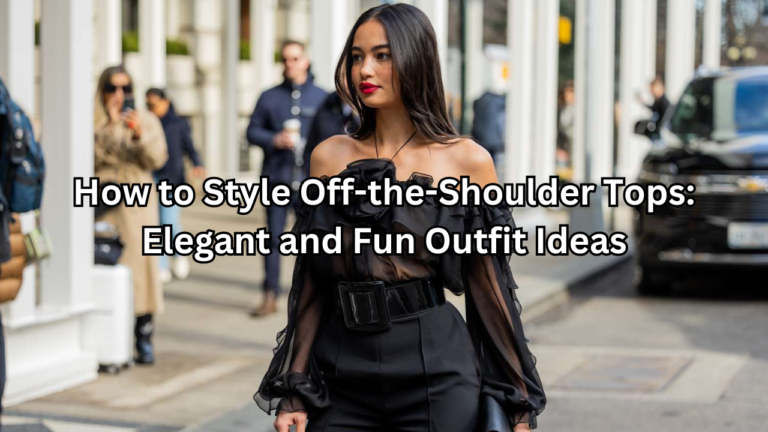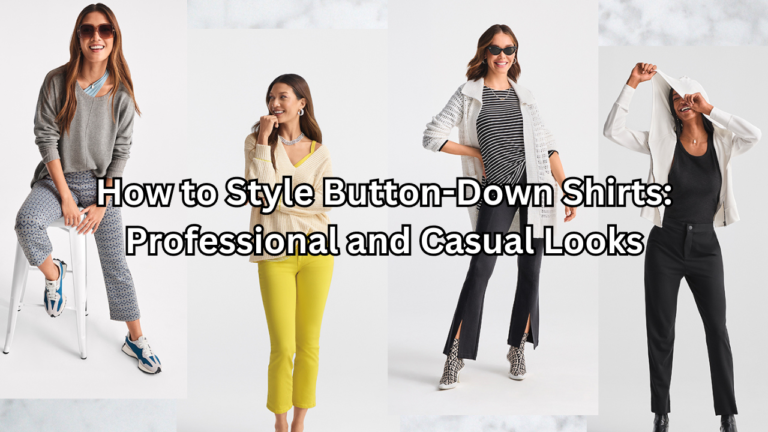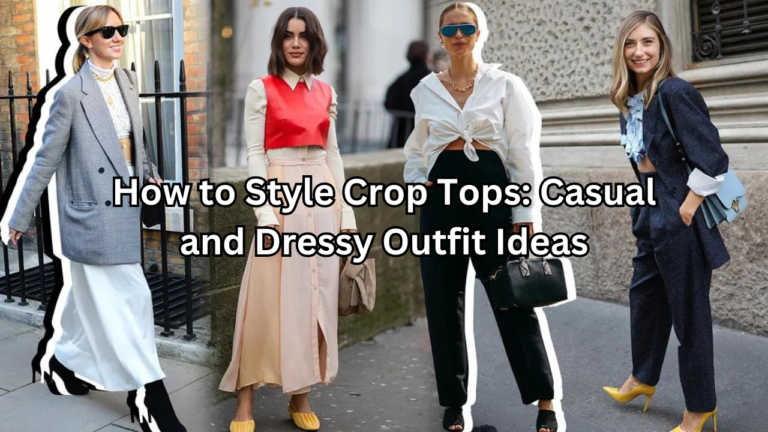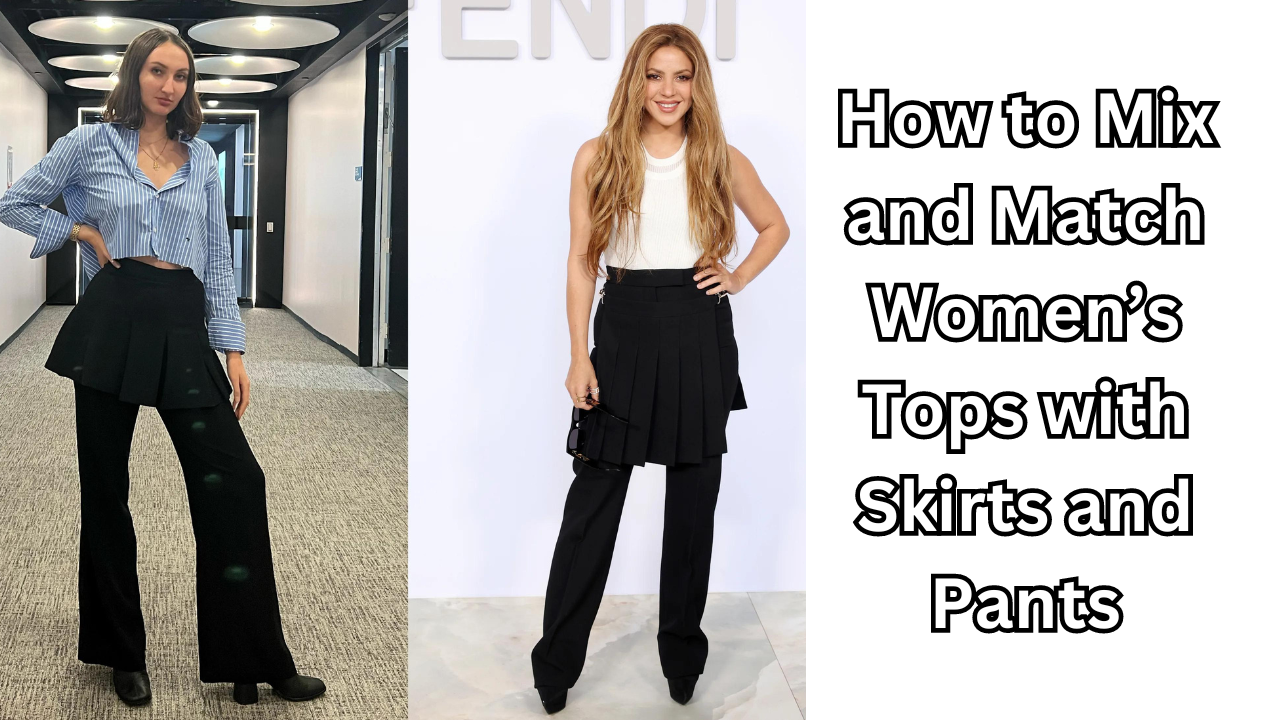
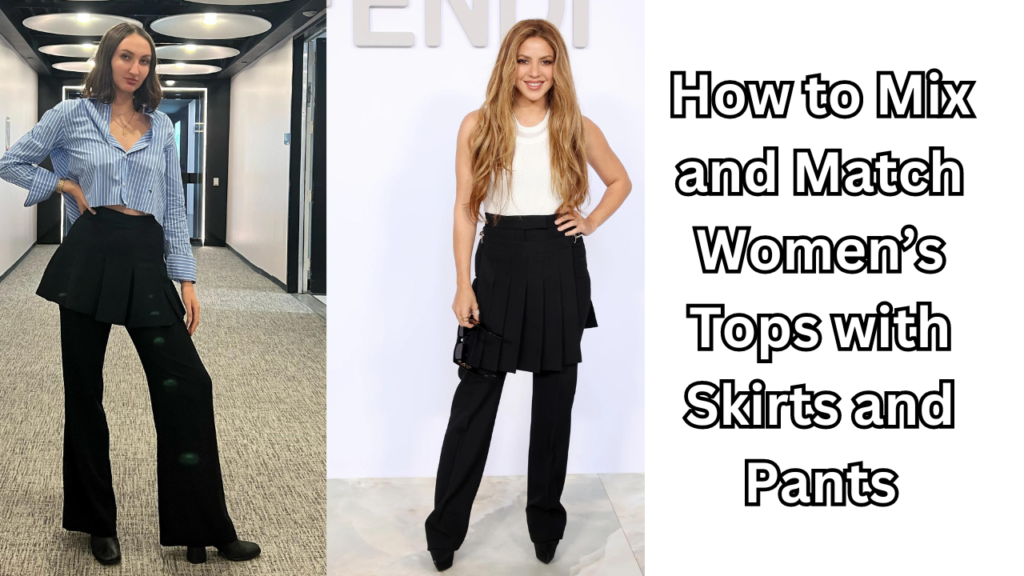
Table of Contents
Introduction
Tops with Skirts and Pants, Balancing tops with bottoms is crucial in crafting well-coordinated outfits that enhance your overall style. A harmonious combination of these two elements not only defines your look but also ensures you’re dressed appropriately for any occasion. Mastering this balance can elevate your wardrobe, making it easier to mix and match pieces while maintaining a cohesive appearance.
The goal of creating versatile, stylish outfits lies in finding the perfect equilibrium between your tops and bottoms. By understanding how to pair various styles, fabrics, and fits, you can build a wardrobe that adapts to different settings and personal preferences. This approach not only enhances your fashion sense but also ensures you make the most of your clothing, allowing you to express your unique style effortlessly.
How to Identify Your Body Shape
Understanding your body shape involves evaluating the proportions of your shoulders, waist, and hips. Start by taking accurate measurements of these areas. Compare these measurements to determine which parts of your body are relatively larger or smaller. Pay attention to the overall silhouette that emerges. Common body shapes include:
- Pear Shape: Characterized by narrower shoulders and a wider hip, with most weight carried around the hips and thighs.
- Apple Shape: Features a fuller upper body with broader shoulders and a rounded midsection, with less definition at the waist.
- Hourglass Shape: Noted for a balanced bust and hip measurement with a distinctly narrower waist.
- Rectangle Shape: Marked by a more uniform bust, waist, and hip measurement, creating a straighter silhouette.
Recognizing these patterns helps in selecting clothes that highlights your strengths and creates a well-proportioned look.
Choosing Tops with Skirts and Pants That Complement Your Figure
Selecting the right tops and bottoms can significantly enhance your overall appearance. Here’s how to choose pieces that complement your specific body shape:
- Pear Shape: Opt for high-waisted skirts or pants to balance the lower body and create a streamlined effect. Pair these with tops that draw attention to the upper body, such as off-shoulder styles or tops with interesting necklines and embellishments. This combination helps to balance the proportions and highlight your upper body.
- Apple Shape: Look for flowy or asymmetrical tops that skim over the midsection to create a more balanced silhouette. High-waisted bottoms or tailored trousers can help elongate the legs and define the waist. Structured tops that offer a bit of shape without clinging can also help to create a more streamlined appearance.
- Hourglass Shape: Fitted tops and bottoms that accentuate the waist work best for hourglass figures. Choose tops that hug your curves and pair them with high-waisted skirts or trousers. This emphasizes your natural curves and maintains a balanced, proportional look. Additionally, belts can be used to further define the waist.
- Rectangle Shape: To create the illusion of curves, opt for tops with ruffles, peplums, or layered details that add volume to the upper body. Pair these with bottoms that have some structure, such as belted trousers or skirts, to introduce some definition to your waist and hips. This approach adds dimension and shape to a straighter silhouette.
By understanding your body shape and choosing complementary styles, you can create outfits that enhance your natural features and make you feel confident and stylish.
Types of Tops and Their Best Matches
Button-Down Shirts: Button-down women shirts are versatile staples that can be dressed up or down, making them suitable for various occasions. For a polished look, pair a button-down shirt with tailored trousers or a pencil skirt. This combination is ideal for professional settings or formal events. For a more casual outfit, tuck a button-down into high-waisted jeans or a skirt, and roll up the sleeves for a relaxed yet put-together appearance. Experiment with different textures and patterns, such as stripes or checks, to add interest and personality to your outfit.
Blouses: Blouses offer a range of styles and can be matched with various skirts and pants to suit different occasions. For a classic, elegant look, pair a flowy blouse with a midi or A-line skirt. This combination adds a touch of sophistication while allowing for comfortable movement. If you prefer a more tailored look, tuck a structured blouse into high-waisted trousers or a pencil skirt. The contrast between the blouse’s flowy fabric and the structured bottoms creates a balanced and polished appearance. Consider blouses with details like ruffles or bows for added flair.
T-Shirts and Tanks: T-shirts and tanks are perfect for casual wear and can be paired with a variety of bottoms. For a laid-back daytime look, combine a basic t-shirt with denim shorts or jeans. This classic pairing is both comfortable and stylish. When transitioning to cooler weather, layer a tank top with a cardigan and pair it with high-waisted trousers or a midi skirt. This combination adds versatility to your wardrobe and allows you to adapt your casual pieces for different seasons.
Crop Tops: Crop tops can create a balanced look when paired with the right bottoms. For a chic and streamlined appearance, combine a fitted crop top with high-waisted skirts or trousers. This pairing highlights the waist and creates a flattering silhouette. For a more casual approach, pair a loose or flowy crop top with high-waisted shorts or jeans. This combination is perfect for warmer weather and offers a relaxed yet stylish vibe. Experiment with different crop top lengths and styles to find the best fit for your body type and personal style.
Sweaters and Cardigans: Sweaters and cardigans are essential for layering and can be paired with various skirts and pants to create different looks. For a cozy, casual outfit, layer a chunky sweater over high-waisted jeans or leggings. This combination is both comfortable and stylish for cooler days. To add sophistication, pair a fitted sweater with a midi skirt or tailored trousers. Cardigans, especially long or oversized styles, can be layered over dresses or skirts for added warmth and a relaxed look. Experiment with different fabrics and lengths to create versatile and fashionable outfits.
Types of Tops with Skirts and Pants Best Matches
A-Line Skirts: A-line skirts are known for their flattering, flared shape that cinches at the waist and gradually widens towards the hem. To achieve a balanced silhouette, pair an A-line skirt with fitted tops or blouses. A tucked-in button-down shirt or a form-fitting turtleneck complements the skirt’s shape and highlights your waistline. For a more relaxed look, you can also opt for a slightly loose blouse or crop top that ends at the waistline, creating a cohesive, well-proportioned appearance.
Pencil Skirts: Pencil skirts are designed to hug the body and provide a sleek, streamlined look. To enhance this silhouette, choose tops that add structure or contrast. A tailored button-down shirt or a fitted blouse tucked into the skirt will accentuate the waist and create a polished, professional look. For a modern twist, pair the pencil skirt with a cropped sweater or a fitted turtleneck, which can also help to define the waist and maintain a sleek profile.
Maxi Skirts: Maxi skirts offer a flowing, elegant look that can be complemented with a variety of tops. For a chic appearance, opt for fitted tops like a cropped shirt or a form-fitting tank top that contrasts with the skirt’s volume. Tucking in the top or knotting it at the waist can help to define your shape and balance the flowy nature of the maxi skirt. Alternatively, a lightweight blouse with a tucked-in or knotted style can add a touch of sophistication while maintaining a relaxed vibe.
Mini Skirts: Mini skirts are playful and trendy, and they pair well with tops that create a stylish contrast. For a youthful, fun look, combine a mini skirt with a casual t-shirt or a graphic tee. This combination is ideal for casual outings or weekend wear. To elevate the mini skirt for a night out or a more polished look, pair it with a fitted blouse or a crop top. High-waisted mini skirts also work well with off-the-shoulder tops or tailored blouses to create a balanced and fashionable outfit.
Types of Pants and Their Best Matches
High-Waisted Pants: High-waisted pants are perfect for emphasizing the waist and creating a defined silhouette. To highlight this feature, pair them with tops that tuck in or are cropped. A fitted blouse or a tucked-in button-down shirt enhances the waistline and maintains a streamlined look. For a more relaxed style, opt for a crop top that ends just above the waistband, which can accentuate your waist while providing a chic, balanced appearance.
Wide-Leg Pants: Wide-leg pants offer a flowy, relaxed fit that benefits from balanced top choices. To achieve a harmonious look, pair wide-leg pants with fitted or cropped tops that create contrast with the voluminous bottoms. A tucked-in blouse or a form-fitting sweater can help to define the waist and prevent the outfit from appearing too bulky. Alternatively, a fitted turtleneck or a structured crop top can also complement the wide-leg silhouette effectively.
Skinny Jeans: Skinny jeans provide a sleek, streamlined base that pairs well with various tops. To complement the narrow fit of the jeans, choose tops that add visual interest or volume. A flowy blouse or an oversized sweater can provide a stylish contrast, while a fitted shirt or a tailored jacket can maintain a balanced look. Layering with a structured blazer or adding a belt can also enhance the overall outfit and provide additional definition.
Culottes: Culottes are versatile pants that offer a modern, fashionable vibe. To create a cohesive look, pair culottes with fitted or tailored tops that enhance the proportions of the outfit. A cropped top or a structured blouse works well to balance the wide leg of the culottes and create a refined silhouette. For a chic, sophisticated appearance, consider layering with a tailored jacket or a slim-fit sweater.
Balancing Proportions
How to Balance Volume and Fit Between Tops and Bottoms: Achieving a balanced look involves harmonizing the volume and fit of both your tops and bottoms. When wearing voluminous bottoms, such as wide-leg pants or A-line skirts, opt for fitted or tailored tops that define your waist and create a balanced silhouette. Conversely, when wearing more fitted bottoms like skinny jeans or pencil skirts, choose looser or more relaxed tops to add visual interest and avoid a restrictive appearance. The key is to create a proportionate look that enhances your natural shape and provides a harmonious outfit.
Tips for Creating a Harmonious Look: To ensure a harmonious look, consider the proportions of your outfit and choose pieces that complement each other. Mix and match different fits and volumes to create balance, and pay attention to the overall silhouette. Experiment with layering to add depth and interest while maintaining a cohesive appearance. For example, pair a structured top with flowing bottoms or a relaxed top with tailored pants to achieve a well-rounded look. Ensuring that the outfit feels balanced and visually appealing will enhance your style and confidence.
Color Coordination
Basics of Color Matching: Effective color matching involves understanding the color wheel and selecting hues that complement each other. Stick to a color palette that either contrasts or harmonizes to create a visually pleasing outfit. Neutral colors like black, white, and gray are versatile and can be paired with virtually any color. For more vibrant outfits, use complementary or analogous colors to achieve a balanced and cohesive look. Consider the occasion and mood you want to convey when choosing your colors.
Combining Prints and Patterns Effectively: When combining prints and patterns, aim for balance and coordination. Start by choosing one dominant pattern and pair it with complementary or neutral prints to avoid overwhelming the outfit. For example, a striped top can be paired with a patterned skirt or pants that share similar color tones. Alternatively, mix patterns of different scales—such as a large floral print with a smaller geometric design—to create visual interest without clashing. Ensure that the colors and patterns harmonize to maintain a cohesive and stylish appearance.
Accessorizing Your Outfit
Choosing Accessories to Enhance the Overall Look: Accessories play a crucial role in elevating your outfit and adding a personal touch. Select accessories that complement the style and color of your outfit, such as statement necklaces for a dressy look or minimalistic jewelry for a more casual appearance. The right accessories can accentuate your features, highlight your personal style, and complete your overall look.
How Accessories Can Transform a Basic Outfit: Accessories have the power to transform a basic outfit into something extraordinary. A simple dress or pair of jeans can be elevated with the addition of a stylish belt, statement earrings, or a chic handbag. Accessories add flair, texture, and color, creating a polished and fashionable appearance. Experiment with different accessories to find combinations that enhance your outfit and reflect your personal style, making even the simplest ensembles stand out.
Seasonal Considerations
Adapting Top and Bottom Combinations for Different Seasons: Adjusting your outfits to fit the season is key to maintaining both style and comfort. In summer, opt for lightweight fabrics such as cotton and linen for tops and bottoms to stay cool. Pair breezy tops with shorts or skirts and sandals for a fresh, comfortable look. In fall and winter, layer with warmer fabrics like wool or knit, and choose heavier bottoms like trousers or jeans. Layering tops with sweaters or cardigans and accessorizing with scarves and boots can help you stay warm while looking stylish.
Layering Tips for Varying Weather Conditions: Effective layering is essential for transitioning between different weather conditions. Start with a base layer, such as a fitted t-shirt or tank top, which can be easily adjusted as temperatures change. Add mid-layers, like cardigans or lightweight sweaters, for additional warmth. Finally, top off your outfit with outer layers such as jackets, blazers, or coats that can be removed when indoors. Choose versatile, removable layers that offer both style and practicality to adapt to fluctuating weather.
Office Wear vs. Casual Wear
How to Mix and Match for a Professional Look: Creating a professional look involves balancing sophistication with comfort. Start with tailored or structured pieces like blazers, button-down shirts, and pencil skirts or tailored trousers. Opt for classic colors and subtle patterns to maintain a polished appearance. Mix and match these items to create versatile outfits—pair a blazer with a button-down and trousers for a meeting or a pencil skirt with a fitted blouse for a business casual look. Accessories should be kept minimal and refined, such as a simple watch or stud earrings.
Creating Stylish Yet Comfortable Outfits for Casual Outings: For casual outings, prioritize comfort without sacrificing style. Choose relaxed, versatile pieces such as well-fitted jeans or comfortable leggings paired with casual tops like graphic tees, oversized sweaters, or flowy blouses. Layer with denim jackets or casual cardigans for added warmth and style. Incorporate comfortable footwear such as sneakers or flats and accessorize with functional yet trendy items like crossbody bags or casual scarves. This approach ensures you look effortlessly stylish while remaining comfortable.
Mixing Patterns and Textures
Guidelines for Pairing Different Patterns and Textures: Successfully mixing patterns and textures involves achieving balance and harmony. Start by choosing one dominant pattern and pair it with subtle, complementary patterns or solid colors. Ensure that patterns share similar color tones or styles to avoid clashing. When mixing textures, consider combining fabrics that contrast yet complement each other, such as pairing a knit sweater with a leather skirt or a silk blouse with denim jeans. This adds depth and interest to your outfit without overwhelming it.
Examples of Successful Pattern and Texture Combinations: Some effective combinations include:
- Stripes and Florals: A classic striped shirt can be paired with a floral skirt, where the stripes add a structured look while the florals provide a softer, more dynamic element. Ensure the colors of both patterns complement each other.
- Plaid and Denim: A plaid shirt or blazer works well with denim jeans or skirts, offering a balanced look where the structured pattern of plaid contrasts with the casual texture of denim.
- Leathers and Knits: Pairing a leather jacket with a cozy knit sweater and trousers can create a stylish contrast, adding both edge and warmth to your outfit.
These examples demonstrate how thoughtful pattern and texture combinations can elevate your outfit and create a visually appealing, cohesive look.
Trend Alerts
Current Trends in Tops and Bottoms Mixing: Fashion trends constantly evolve, bringing new ways to mix and match tops and bottoms. Currently, oversized blazers are trending as a versatile piece that pairs well with everything from high-waisted jeans to tailored trousers. High-waisted, wide-leg pants are also in vogue, often styled with cropped tops or fitted sweaters. Additionally, the monochrome look—where tops and bottoms are in the same color family—continues to be popular, creating a sleek, unified appearance. Bold prints, such as animal patterns and geometric designs, are being mixed for a statement-making outfit.
How to Incorporate the Latest Fashion Trends into Your Outfits: To incorporate the latest trends, start by choosing a few key pieces that align with current styles. For example, if oversized blazers are trending, invest in one that fits your personal style and pair it with both casual jeans and dressier trousers. When adopting monochrome or bold print trends, select versatile pieces that can be styled in multiple ways. Layering and accessorizing with trendy items, like statement belts or chunky sneakers, can also help integrate the latest fashion into your wardrobe without overwhelming your personal style.
Styling Tips for Special Occasions
Outfits for Formal Events, Parties, and Special Occasions: For formal events, opt for elegant and sophisticated outfits. Classic choices include a tailored suit or a chic cocktail dress paired with high heels and refined accessories. For parties, you can choose a stylish jumpsuit or a dress with bold patterns or sequins to make a statement. Special occasions like weddings may call for a dressy, well-fitted gown or a polished ensemble with a focus on formal wear. Consider the dress code and venue to ensure your outfit is appropriate and stylish.
How to Dress Up or Dress Down Based on the Event: Dressing up or down depends on the formality of the event. For upscale events, focus on high-quality fabrics, tailored fits, and elegant accessories. Choose classic colors and styles that exude sophistication. For more casual or semi-formal gatherings, you can play with relaxed yet stylish outfits—think a dressy blouse with tailored jeans or a smart jumpsuit. Accessories can also be adjusted based on the occasion; opt for understated pieces for formal events and bolder accessories for more casual or festive occasions.
Creating a Versatile Wardrobe
Building a Collection of Tops and Bottoms That Can Be Mixed and Matched: A versatile wardrobe allows for endless outfit combinations, maximizing the use of each piece. Start with a foundation of neutral tops and bottoms that can be easily mixed and matched. Invest in classic items such as a white button-down shirt, well-fitted jeans, and tailored trousers. Add in versatile pieces like a blazer or a simple sweater that can be dressed up or down. Incorporate a few statement pieces and seasonal items to keep your wardrobe fresh and adaptable.
Tips for Investing in Versatile Pieces: When investing in versatile pieces, focus on quality and timeless styles. Choose clothing items that fit well and are made from durable materials, ensuring they will last through multiple seasons. Opt for neutral colors and classic cuts that can be paired with various other items in your wardrobe. Versatile pieces should also be adaptable—consider items that can be layered or accessorized differently to create diverse looks. By selecting versatile and high-quality pieces, you build a wardrobe that offers both flexibility and style.
Conclusion
Recap of Key Points: Tops with Skirts and Pants, we’ve explored the essential elements of styling tops and bottoms to create fashionable and balanced outfits. We covered how to identify your body shape and select complementary pieces, the best ways to mix and match various types of tops and bottoms, and how to adapt your wardrobe for different seasons and occasions. We’ve also touched on color coordination, accessorizing, and incorporating current fashion trends. By understanding these principles, you can build a versatile wardrobe that enhances your style and suits various settings.
Tops with Skirts and Pants: Fashion is a creative and personal expression, and the best way to discover what works for you is to experiment with different combinations and styles. Don’t be afraid to try new trends, mix patterns and textures, or explore various outfits for different occasions. Play around with layering and accessorizing to find unique looks that reflect your personality. Remember, the key to a great wardrobe is versatility and confidence—embrace the opportunity to create stylish, customized outfits that make you feel your best.
